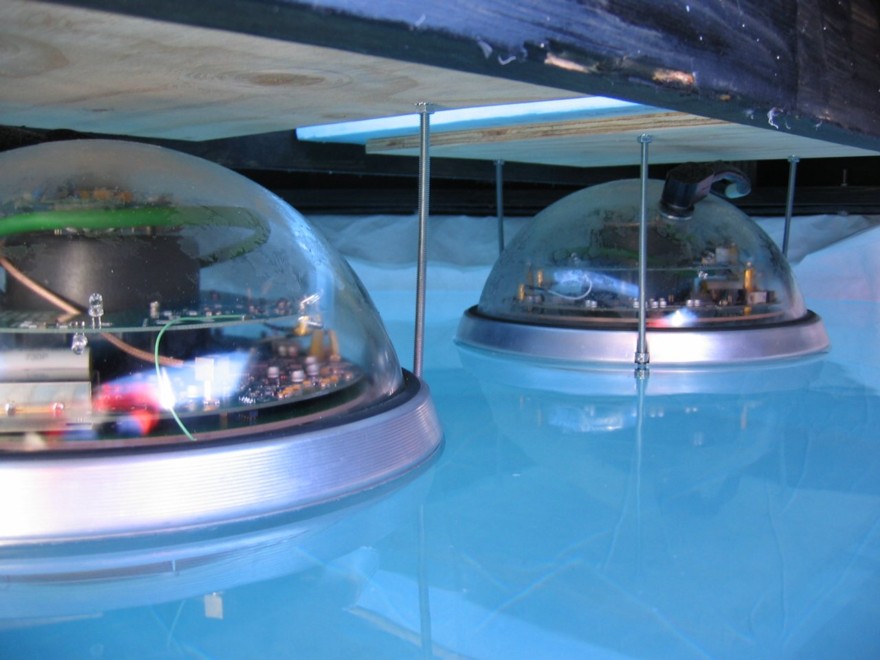Since the 1950s and the beginning of the “space race” scientists have wanted to practice astronomy and particle physics using high-energy neutrinos. So what’s stopping them? The challenge of building the kilometer-sized observatory they predict is needed to do the science. Enter IceCube, a revolutionary new design in neutrino detecting telescopes. Deep in the frozen wastelands at the South Pole, the world’s most extreme telescope will search for neutrinos from our Universe’s most violent astrophysical sources.
Those impossibly tiny particles known as neutrinos are produced by the decay of radioactive elements and elementary particles such as pions. Unlike photons or charged particles, neutrinos originate from deep within exploding stars, gamma ray bursts, and cataclysmic phenomena involving black holes and neutron stars and make their way throughout our Universe, eluding capture and study. Nothing stops a neutrino… Unless it crashes into an atom in ice.
When the rare neutrino collides with an atom in the ultra-transparent ice, it produces a muon that in turn radiates blue light. By observing this fluorescence, scientist can then detect the path of the muon and in turn the path of the neutrino. But, this kind of work really requires seeing in the dark – total dark. By using the Earth as a type of telescope optical tube assembly, neutrinos can enter into the North Pole just as photons enter into a primary objective lens. When they interact with the pure, uncontaminated ice at Earth’s South Pole it’s a whole lot like reaching a telescope’s secondary optic. The Earth itself, like an optical tube, keeps stray photons aways and the fluorescence produced with the muon can then be collected and studied.
So what’s all the fuss about neutrinos? Say Project IceCube: “The basic motivation is to understand our Universe, specifically what powers the most energetic engines in the cosmos and fuels the bombardment of cosmic rays to the Earth. We also want to understand the nature of Dark Matter. At the end, the stuff from which we are made is only 4% of the Universe’s inventory, whereas Dark Matter is 23%. These are motivations dominantly driven by curiosity, by the dream of mankind to understand our origins, our place in the cosmos, and a far future much beyond our human horizons.”
In short, IceCube is one cool telescope!
This material is based upon work supported by the National Science Foundation under Grant Nos. OPP-9980474 (AMANDA) and OPP-0236449 (IceCube), University of Wisconsin-Madison. Photo by Daan Hubert/NSF


How long before global warming makes the Ice Cube impossible?
“Unless it crashes into an atom of ice.”
Interesting, since when is there such a thing as an atom of ice? Must be some really, really new physics!
Wait a sec., did you say “..until it crashes into an atom of ice.” and then “..enter into the North Pole..”, and then ,”..interact with the…ice at the South Pole”. How does it miss all of the ice at the North Pole, and I’m told there’s a lot up there too?
For ScepticTim: Nice catch! It did read “atom of ice”… Now reads “atom in ice”. Two letters… I miss two little letters that spell check said was ok and ya’ found it! Wonder if they’ll ever come up with a “duh checker”? 😉
For the_nthian: You can bet that neutrinos are crashing into atoms in the North Polar ice, too… Most of these neutrinos will come from “cascades” in Earth’s atmosphere caused by cosmic rays, but some unknown fraction may come from astronomical sources. To distinguish these two sources statistically, the direction and angle of the incoming neutrino is estimated from its collision by-products. One can generally say, that a neutrino coming from above “down” into the detector is most likely stemming from an atmospheric shower, and a neutrino traveling “up” from below is more likely from a different source.
Why the South Pole instead of the North? “In order to build the IceCube telescope, we had to find the clearest and purest ice we could find in as large a quantity as possible. In most ice, air bubbles and air pockets form which would distort our measurements. The south pole is basically an enormous glacier and consists almost entirely of ice. This ice is under extreme amounts of pressure as more and more snow falls and the water and ice are compressed tightly until it has been rendered into its purest form. IceCube detects the blue light made by the nuclear reaction initiated by a direct hit of a neutrino on an atom of ice. These hits are rare and it therefore requires a lot of atoms, actually a kilometer cube of ultra transparent ice to do the science. The instrumented ice has to be shielded from the natural radiation at the surface, in our case by a layer of 1.5 kilometer of ice covering IceCube. To build a detector of this complexity requires a scientific infrastructure. The South Pole station constructed on three kilometers of clear natural ice presents us with the opportunity to satisfy all requirements and make neutrino astronomy a reality.”
How long before global warming makes IceCube ineffective? Probably right up until the time our atmosphere is gone and cosmic rays eat away our brains… 😉
I thought that they already found neutrinos in those things they put in the bottom of Lake Erie years ago?
wow i didnt think ice was so complicated